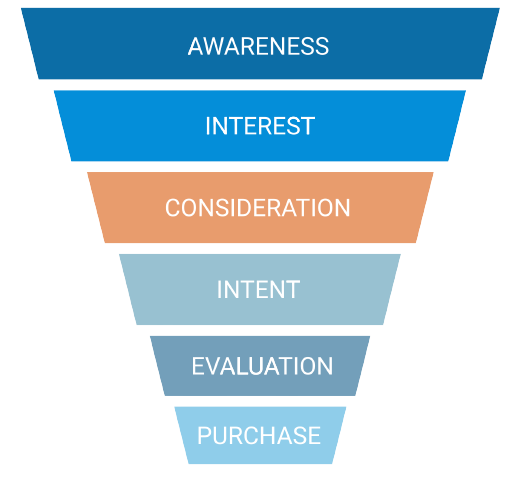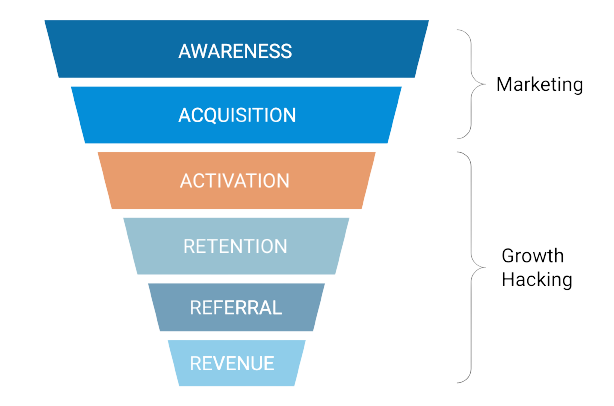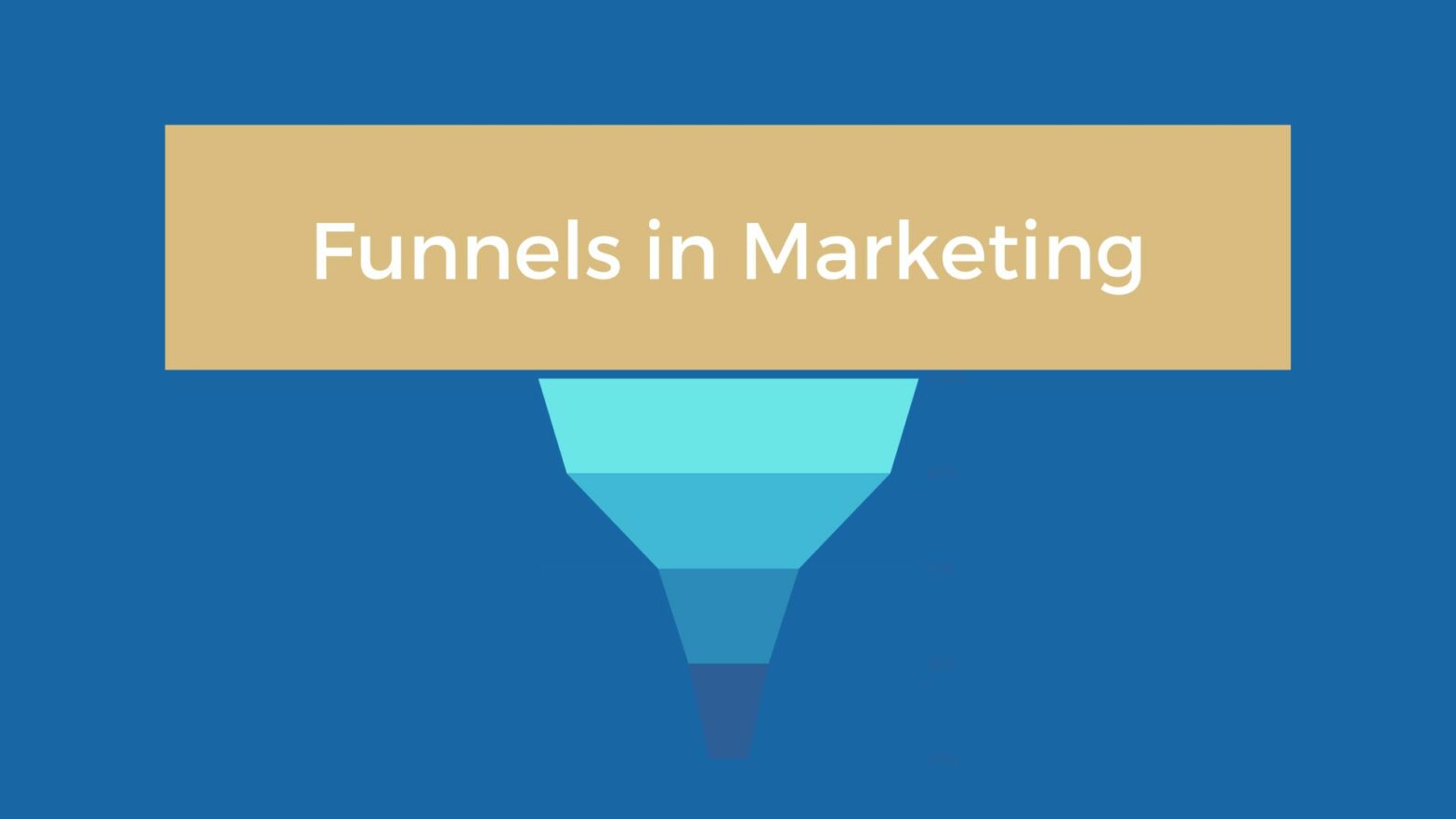For many years, the concept of funnels has been discussed in marketing, and particularly in digital marketing. But what exactly are these funnels? And how do you set up a funnel, and what is the purpose of all this? In the following paragraphs, I will try to clarify the funnel topic and provide some examples.
Table of contents:
- What is a funnel – in Digital Marketing
- What do I need a marketing funnel for
- The Growth Hacking Funnel
What is a funnel – in Digital Marketing
Inhaltsverzeichnis
A marketing funnel is a model that illustrates the customer journey from their first contact with a brand to the purchase of a product or service. Imagine a funnel where many potential customers enter at the top, and only those who have actually made a purchase come out at the bottom. The process is divided into various stages, such as:

- Attention: In this phase, potential customers become aware of the brand or product, for example, through advertising across various channels or word of mouth.
- Interest: Potential customers begin to show interest in the product or service and search for more information, such as on the internet.
- Desire or Decision: Customers compare different options and decide on the product or service that best meets their needs. At this point, the potential customer might visit the manufacturer’s or product’s website, or browse comparison platforms.
- Action: Customers make the purchase and become paying customers.
A marketing funnel helps businesses optimize their marketing strategy by presenting engaging content and offers to customers at each stage of the funnel. The goal is to convert as many potential customers as possible into paying customers.
Here, we adhered to the relatively simple AIDA model (Attention, Interest, Desire, Action).
This would be a relatively simple funnel variant to demonstrate (and measure) how the customer journey can unfold. Of course, there are many different variations and specializations of marketing funnels.
A more sophisticated and complex funnel would be one that includes two additional stages, for example.

It is also very interesting to compare the phases of this funnel and corresponding activities for B2C and B2B. For example, it could look like this:
| Stage | B2C | B2B |
|---|---|---|
| Awareness | Information search | Information search |
| Interest | Find details about the product, product comparison platforms | Find details about the product, find similar products, B2B product review platforms |
| Consideration | Narrow down the selection to a few products that are eligible for purchase | Narrow down the selection and discuss product information with colleagues and stakeholders internally. Create a checklist |
| Intent | Add product to shopping cart | Request a product demo (or start a free product trial) |
| Evaluation | Question the product in the shopping cart / think briefly | Contract draft or specifications are evaluated |
| Purchase | Purchase of the product completed | Purchase of the product completed |
What do I need a marketing funnel for?
A marketing funnel or the graphical representation of it can be very helpful to put yourself in the customer’s shoes and the phases of a buying process. The funnel is a helpful concept to visualize the decision and buying process of a customer. Furthermore, a funnel helps to define KPIs that match the respective stage and also to clearly display and calculate conversion rates from one stage to the next.
This gives you a lot of clues for growth hacking measures and is also a good way to quantify and measure them.
So a marketing funnel and the visualization of it helps to:
- Identify bottlenecks: A marketing funnel shows at which points potential customers leave the process (so-called “drop-offs”). This allows bottlenecks to be identified that require improvement in order to increase the conversion rate.
- Measure effectiveness of marketing and sales efforts: By tracking customers’ progress through the funnel, you can assess and adjust the effectiveness of various marketing and sales efforts to achieve better results.
- Analyze and improve customer engagement: Using the funnel, one can develop strategies to engage customers at each stage of the decision-making process, increasing the likelihood of a purchase or other desired action.
- Optimize targeting: The funnel helps to better segment audiences and develop personalized messages or offers tailored to the needs and interests of customers at different stages of the funnel.
The Growth Hacking Funnel
You can build a funnel for just about any process. For example, also for an application process for a job. Here the HR department could measure their KPIs. E.g.: 100 clicks on the job ad. Of these 50 applications arrived at the company. Of these, 5 were invited for the first interview. Of these, 1 candidate was accepted.
But back to the Growth Hacking Funnel. There are also useful funnels in the growth hacking area to visualize the measures and make them measurable.
The most famous one is the “Pirate” or “AARRR” Funnel:

Here are these phases and also equal example activities to it:
- Acquisition: This phase is about making potential customers aware of the SaaS product and bringing them to the website or platform. Activities:
- Content marketing (blog posts, whitepapers, webinars) to increase brand awareness and create technical articles.
- Search engine optimization (SEO) and search engine advertising (SEA) to increase visibility in search results.
- Social media marketing and targeted LinkedIn ads to reach the right audience.
- Participation in industry events, trade shows and conferences to present the product in person and make contacts.
- Activation: This is about getting the potential customers interested in the product and trying it out. Activities:
- Offer free trial or demo of the SaaS product to give potential customers a glimpse of its functionality and benefits.
- Onboarding emails and in-app tutorials to help customers get started and learn about key features.
- Live chat support or chatbot to quickly help customers with questions or issues.
- Retention: This phase seeks to build long-term customer loyalty to the product and increase usage. Activities:
- Offer free trial or demo of the SaaS product to give potential customers a glimpse of its functionality and benefits.
- Onboarding emails and in-app tutorials to help customers get started and learn about key features.
- Live chat support or chatbot to quickly help customers with questions or issues.
- Referral: Encourage customers to recommend the product to friends, colleagues and business partners. Activities:
- Implement a referral program that offers customers rewards or discounts for successful referrals.
- Create and publish success stories and case studies from satisfied customers to gain the trust of new prospects.
- Invite customers to leave reviews and testimonials on rating platforms and social media.
- Revenue: Optimize product monetization and increase sales. Activities:
- Develop pricing strategies and plans that are attractive to both small and large businesses and appeal to a broad customer base.
- Offer customized packages and add-ons that allow customers to extend the functionality of the product according to their needs.
- Run regular promotions and limited-time offers to attract new customers and incentivize existing customers to upgrade or renew.
- Analyze data and metrics on sales, churn rate, and customer lifetime value to identify optimization opportunities and implement targeted actions to increase sales.
- Work closely with the sales team to ensure that prospects are effectively targeted and converted and that existing customer relationships are maintained.
If you keep a good eye on and implement these activities at each stage of the AARRR funnel, you have the playbook to attract, retain and monetize customers with your B2B SaaS product while constantly improving the product and customer experience.
Since growth hacking is strongly rooted in the SaaS (Software as a Service) business, these phases make a lot of sense for B2C and B2B SaaS growth hacking, but don’t make quite as much sense in other cases.
The funnel must therefore also fit the product and the industry, otherwise you try to invent things that do not actually exist in the respective phase.
So much for the various marketing funnels with a focus on the Growth Hacking Funnel. In further blogposts I will go into more detail about which KPIs are useful and how you can measure and optimize the whole thing :).
